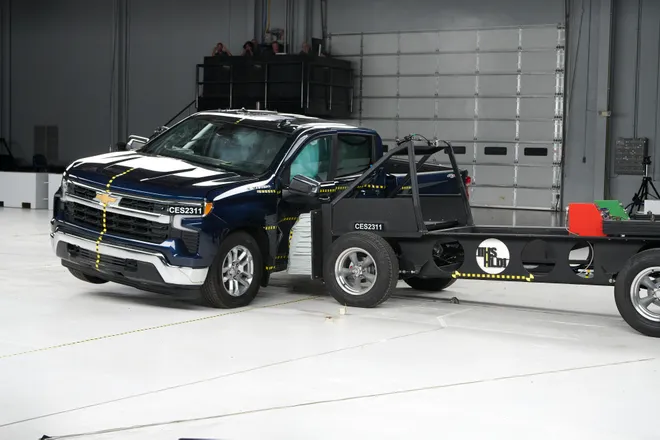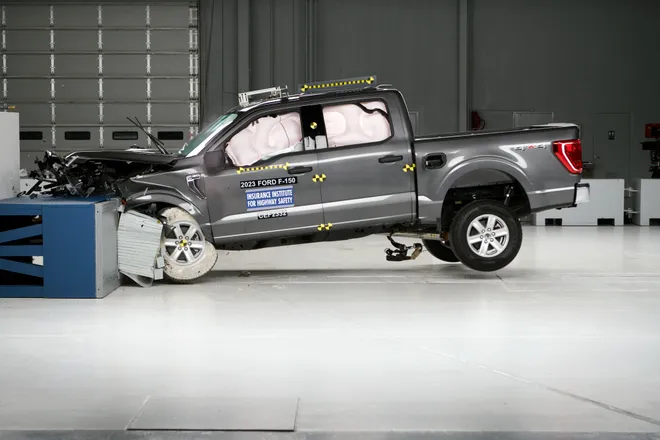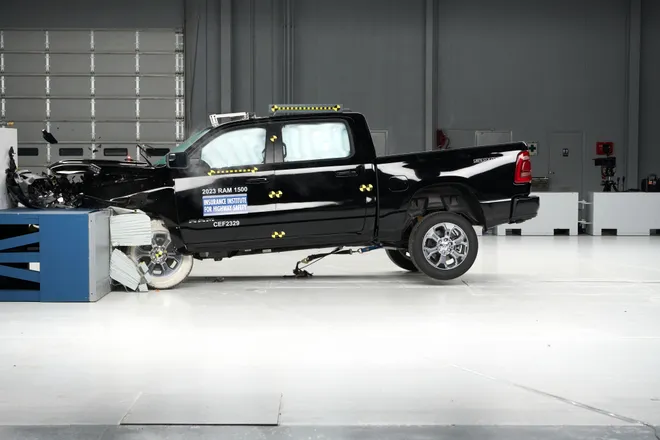A pickup truck crash may be more dangerous for backseat riders, new tests show
Crash test results on large 2023 pickups indicate that back-seat passengers should be especially careful about their posture and seatbelt fit to prevent life-threatening injury during a front collision, according to a new safety study from the Insurance Institute for Highway Safety (IIHS).
Only the Toyota Tundra crew cab earned a marginal rating while the crew cab versions of the Ford F-150, Ram 1500 and Chevrolet Silverado rated poor.
The safety group, which tracks crash and injury claims, started the test after research showed newer trucks have a higher risk for fatal injury in the second row.
The front seat is safer because of improved airbags and seatbelts. This latest rating does not affect babies or young children secured in child safety seats, who may be injured by a front seat airbag. The seatbelt issue does not affect children in safety seats.
The latest test focused on injuries most frequently seen in back-seat passengers.
Internal organs at risk of being crushed
Researchers used a dummy the size of a petite woman or 12-year-old child, which was placed in the back seat behind a driver dummy the size of an average man. To earn a much-desired “good” rating by the institute, the vehicle can’t present excessive risk of injury to the head, neck, chest or thigh — which happens now with the second-row dummy.
In order to avoid injury, the second-row passenger must maintain good posture during the crash. That may sound strange but sitting up will prevent sliding forward underneath the lap belt, which risks serious abdominal injury. The position of sliding under the seatbelt is called "submarining" in the safety industry.
The study showed the backseat passenger’s head must be a safe distance from the front seat and the rest of the interior, called “survival space,” and the shoulder seatbelt should remain on the shoulder. (A pressure sensor is used to check belt positions and impact injury.)
“Submarining was a problem for all four pickups, and belt forces were too high in all but the Tundra,” David Harkey, president of the institute, said in a news release.
Chest injuries and head or neck injuries would be likely in the F-150 and Ram 1500, crash test results showed.
“The risk of those injuries was somewhat lower but still excessive in the Silverado. For the Tundra, the risk of chest injuries was also too high due to poor belt positioning, but the risk of head or neck injuries was only slightly elevated,” the institute said in its news release.

Crash studies have been updated to try to address higher-speed crashes that are still causing fatalities, according to researchers, whose safety data is used by insurance companies to set rates and encourage industry developments.
Crash test results scored on a range of good or acceptable to marginal or poor.
While the Ford F-150, Ram 1500, and Toyota Tundra are built with strong side protection, new testing on 2023 models shows, the Chevrolet Silverado 1500 is rated only acceptable overall because of the risk to rear passengers for chest injury.These new tests shape Top Safety Pick awards issued by the long-established nonprofit safety organization funded by the insurance industry. The F-150, Ram 1500 and Tundra earned an overall "good" rating in a side crash because they provide solid protection in the front and back seats. But the F-150 also rated acceptable on structure and safety cage as well as rear passenger head protection. The Silverado was downgraded overall to "acceptable" because of an increased risk of chest injury for the rear passenger.

Joe Nolan, senior vice president of research at IIHS, told the Detroit Free Press that both cars and trucks have issues with back-seat safety. Paying attention to how people sit is important to prevent injury, he said.
What is the best position for back seat?
But this latest research highlights new challenges for the industry, he said.
“This is the first time automakers have to get graded on how well they’re doing in the rear seat. We’ve been doing the driver position since 1995,” Nolan said. “I expect, now, that they’re focusing on the issue and will be able to get there. For now, there are things you can do. If you’re worried, try to make sure the people in the back have good seating posture, that they’re not slouching or lounging and their seat isn’t reclining. That will contribute to submarining.”
He urged drivers to make sure the back-seat passengers have the lap belt over the pelvic area, which prevents a body from surging forward. When a seatbelt sits too high, against the abdomen instead of bones, the force can crush the organs.
“If it’s a severe enough crash, well, it’s not ideal,” Nolan said. “You want the seatbelt to anchor on hard points of the body, the pelvic and hip bones.”

Data shows that side impact crashes are less frequent but more severe per injury, he said. And automotive designers have made strides in side impact safety design and use of airbags.
Head-on crashes are creating newly discovered safety issues for passengers, and that requires revising “seatbelt geometry” to keep the seatbelt from moving up to the abdomen, Nolan said.
Why car recalls happen:Car recalls: Why they happen and what buyers should know
Check car recalls here:Toyota, Ford, and Jeep among 2.1 million vehicles recalled
Front crash results
- All four trucks earned good ratings for structure and safety of their cage, driver chest protection, knee and thigh protection and restraint. All four trucks ranked good on rear passenger thigh protection but then completely fell apart on rear passenger restraints.
- 2023 Chevy Silverado 1500 crew cab rated poor overall with "acceptable" areas being driver head, neck, leg and foot injury risk. Its passenger risk for head, neck and chest injury is marginal. Rear passenger restraint and kinematics rated poor.
- Both the 2023 Ford F-150 crew cab and 2023 Ram 150 crew cab rated poor overall despite solid "good" ratings for driver injury risk because its rear passenger risk for head, neck, chest and restraint rated poor.
- 2023 Toyota Tundra rated marginal overall with acceptable driver risk for leg and foot injury. For rear passengers, the truck rated acceptable in risk for head and neck injury, marginal risk for chest injury and poor in the area of restraint.
What say you Ram, Ford, Chevy?
Automakers, like the researchers, noted that this is a new test and these vehicles have rated well in safety in the past. And now a new issues has been spotlighted for attention.
Eric Mayne, Ram Truck spokesman, told the Free Press, "We routinely consider third-party ratings and factor them into our product-development process, as appropriate. We engineer our vehicles for real-world performance. The protection of our customers is an integral part of the upfront design of a vehicle's structure. Every Stellantis model meets or exceeds all applicable federal vehicle safety standards."
Bill Grotz, senior manager for global safety communications at General Motors, told the Free Press, “While we are very confident in the overall safety and crashworthiness of our light-duty Chevy Silverado crew cab, we appreciate what the IIHS has done with its new rear seat test protocols. IIHS findings are among the third-party inputs we value as we develop our products and continuously improve passenger safety.”
Mike Levine, director of Ford North America Product Communications, said, "Safety is a top priority, and the 2023 Ford F-150 meets or exceeds all current safety regulations and requirements ... We are always working to continuously improve and we consider IIHS and other third-party feedback in vehicle development."
Contact Phoebe Wall Howard: 313-618-1034 or phoward@freepress.com. Follow her on Twitter @phoebesaid.
Disclaimer: The copyright of this article belongs to the original author. Reposting this article is solely for the purpose of information dissemination and does not constitute any investment advice. If there is any infringement, please contact us immediately. We will make corrections or deletions as necessary. Thank you.







